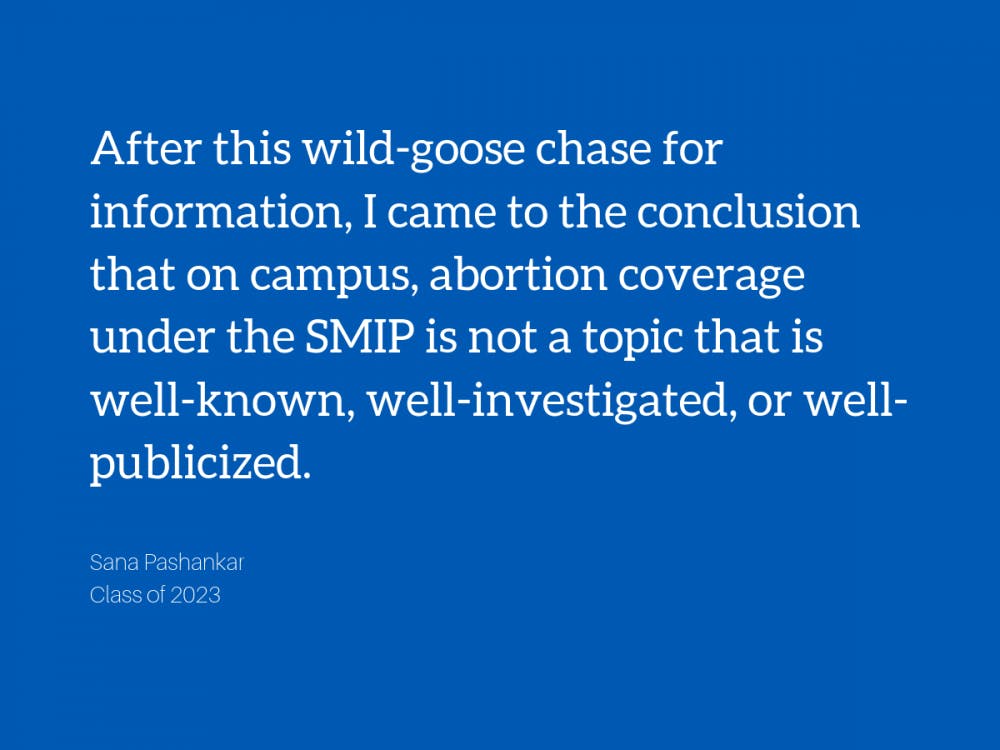Within the US, health insurance coverage of abortion can be a sticky topic. Within universities in the US and their respective student health insurance plans, it can be even stickier. And that is precisely why I set out to investigate the reality of this situation here at Duke. If a woman student looking to terminate her pregnancy needed more information about abortion coverage, where would she go?
The first place I went, of course, was to the Student Health Website. After going through the tabs of Student Health Insurance, I found there, within the fine print of the member guide, the benefits of abortion coverage. Although I noted that abortion coverage was not mentioned in either the summary of the medical benefits on the Student Blue page or the SMIP cheat sheet, the real documents that people look at when they’re looking into the SMIP as their health insurance plan for the next four years, it was there. Benefits for abortion for Duke students are available for the first 16 weeks of the pregnancy.
However, I still had many more questions about the nature of this coverage and so I decided to take further measures to find out the answers to my relatively simple questions about billing, cost of the package, etc. Within this process, however, I encountered a surprising lack of knowledge, lack of transparency, or a simple lack of communication that made me question the access of information that students really have about their insurance plans, specifically abortion.
First, to answer these questions, I logically decided to email the insurance department and the insurance coordinator. After one email and two callbacks later from the insurance coordinator, I finally reached him only to be told that my request for information about insurance coverage had to pass through upper management.
Frustrated and on a deadline, I called the insurance company, Blue Cross/Blue Shield. Once I called Blue Cross/Blue Shield, I was able to speak with a representative, who although very nice, was not helpful. He informed me other universities directly offer different plans that either provide or don’t provide coverage of abortion, and students are able to choose their own plan. However, because students at Duke enroll through our DukeHub account, Blue Cross/Blue Shield was not able to view the specific coverage of our plan and not able to answer the questions I had relating to this coverage.
I also contacted a representative from the Women’s Center, specifying my interest in abortion coverage under the SMIP and the path that women would follow at Duke if they wanted to have an abortion. To my disappointment, she responded saying that this was not her specialty and that I should refer back to the insurance department. Given the fact that abortion is such a prevalent and important issue for women, I was surprised that I was not referred to anyone within the Women’s Center who had information regarding this reproductive right. This presumed lack of knowledge made me question how well-known abortion coverage was known to even professionals around campus.
After contacting the Duke Clinic, the hospital, and going to the Student Wellness Center to no avail, I finally received an email back from Calvin Beacham, from the insurance department, who seemed to be one of the only people on campus able to answer my questions about abortion coverage.
After this wild-goose chase for information, I came to the conclusion that on campus, abortion coverage under the SMIP is not a topic that is well-known, well-investigated, or well-publicized. And this is a problem. The reality is that in America, the rates of abortion among college students are predicted to be high. Even if Duke may not experience high rates of abortion under the SMIP, this issue is one that is relevant for at least half the population of students and should be publicized more.
The lack of knowledge among students and staff may stem from the fact that abortion coverage is not mentioned in either the cheat sheet or the summary of the medical benefits provided on the Student Health Website. Regardless if abortion is covered under the SMIP or not, in an insurance package that is purchased so widely by the student body and with an issue as controversial and important, it needs to be published in bigger font than size 8 on an 83-page document. I am not trying to spout my views on abortion in this column; I am only saying that the gravity of this topic, regardless of how often it is actually utilized under the insurance plan, means that it deserves greater significance than it currently has.
In as sexually active of a population as college students, knowledge about the availability and access to abortion is something that deserves more than just the fine print and should be known by more than just one person on campus.
Sana Pashankar is a Trinity first-year. Her column, small girl, big ideas, runs on alternate Fridays.
Get The Chronicle straight to your inbox
Signup for our weekly newsletter. Cancel at any time.

Sana Pashankar is a Trinity senior and a staff reporter of The Chronicle's 118th volume.

